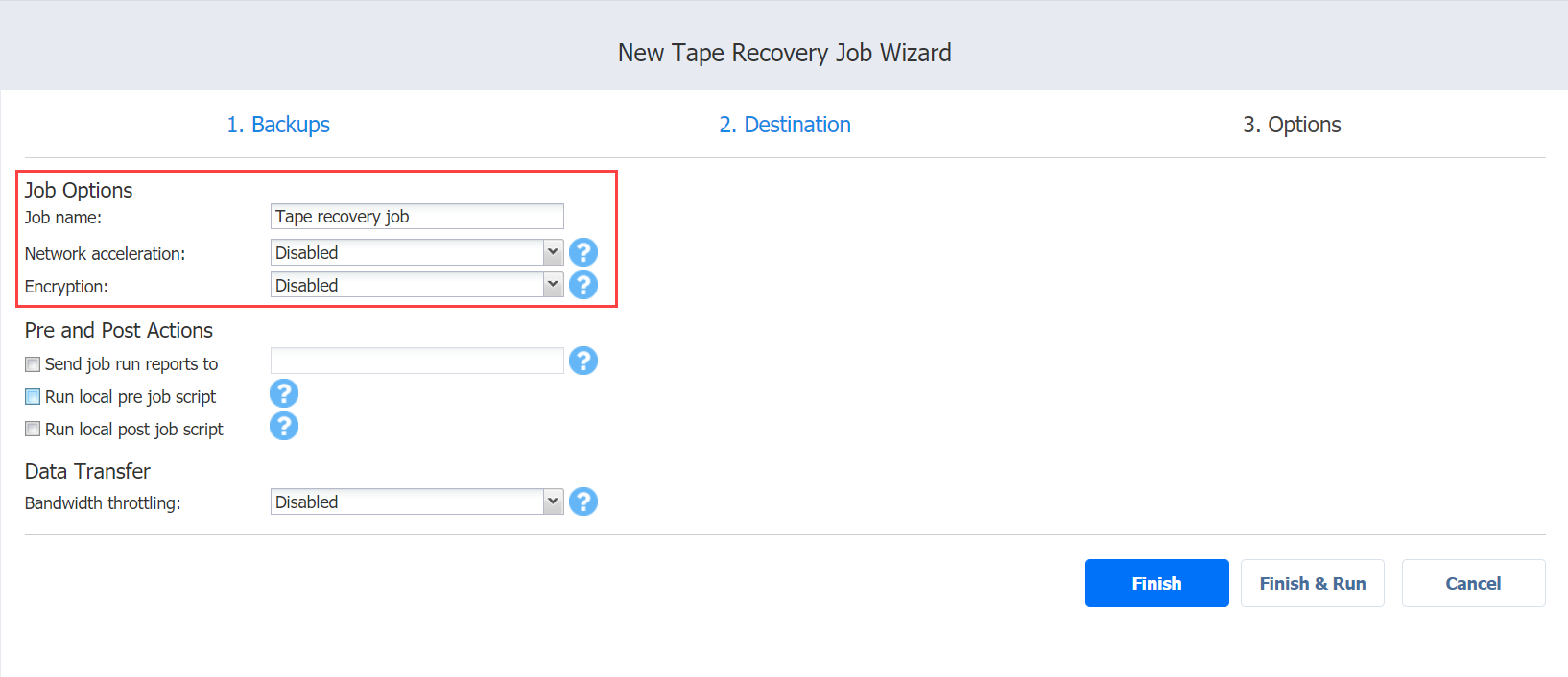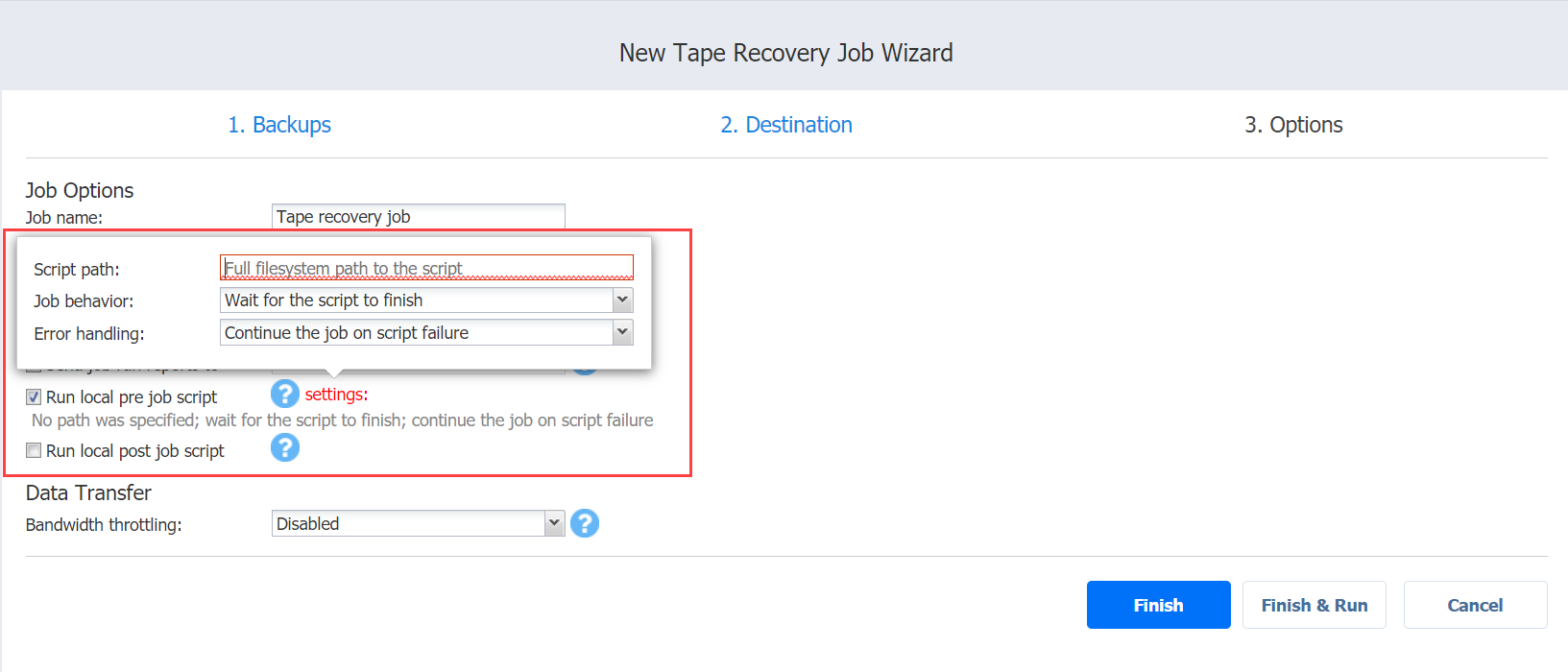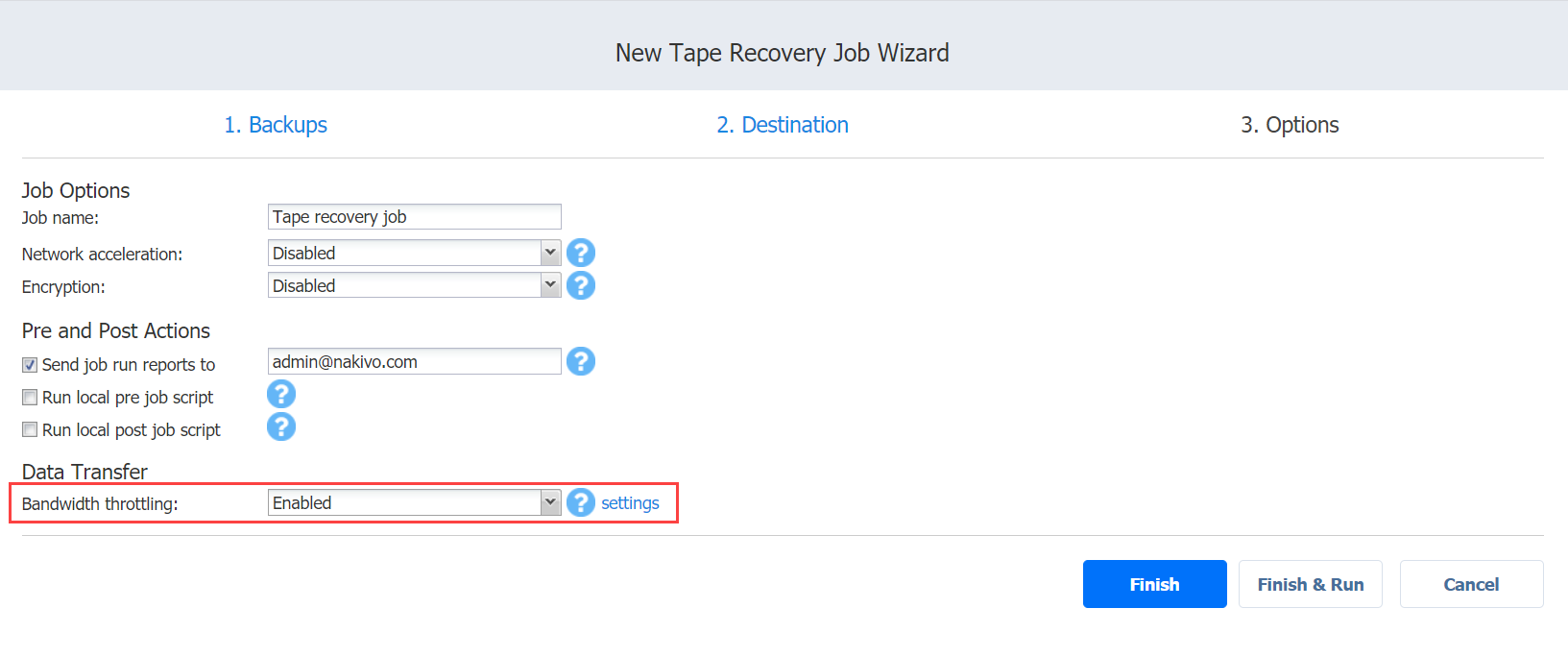Recovery from Tape Wizard: Options
General Options
Specify the general options as follows:
-
Job name: Specify a name for the recovery job.
-
Network acceleration: When network acceleration is enabled, NAKIVO Backup & Replication uses compression and traffic reduction techniques to speed up data transfer. Enable this option if you plan to recover VMs over WAN or slow LAN links. For more information, refer to Network Acceleration.
-
Encryption: When encryption is enabled, VM data is protected with AES 256 encryption while traveling over the network. Data encryption increases the backup time and CPU load on machines running Transporters. Select this option if recovering over WAN without a VPN connection. For details, refer to Encryption in Flight and at Rest.

Pre and Post Actions
NAKIVO Backup & Replication allows you to run a script before VM recovery begins (a pre-job script) and after the recovery of all VMs in the job has completed (a post-job script). The scripts can only be executed on the machine where the Director is installed. Refer to Pre and Post Job Scripts for details.

Setting Up a Pre-Job Script
To run a script before the product begins recovering VMs, do the following:
-
Place a script file on the machine where the Director is installed.
-
Select the Run local pre job script option and click the settings link.
-
Specify the following parameters in the dialog that appears:
-
Script path: Specify a local path to the script on the machine where the Director is installed. A script interpreter should be specified.
-
Example (Windows): cmd.exe /c D:\script.bat
-
Example (Linux): bash /root/script.sh
-
-
Job behavior: Choose one of the following job behaviors in relation to script completion:
-
Wait for the script to finish: With this option selected, VM recovery is only started after the script is completed.
Place a script file on the machine where the Director is installed.
-
-
Select the Run local pre job script option and click the settings link.
-
Specify the following parameters in the dialog that appears:
-
Script path: Specify a local path to the script on the machine where the Director is installed. A script interpreter should be specified.
-
Example (Windows): cmd.exe /c D:\script.bat
-
Example (Linux): bash /root/script.sh
-
-
Job behavior: Choose one of the following job behaviors in relation to script completion:
-
Wait for the script to finish: With this option selected, VM recovery is only started after the script is completed.
-
Do not wait for the script to finish: With this option selected, the product runs the script and starts recovering VMs at the same time.
-
-
Error handling: Choose one of the following job behaviors in relation to scrip failure:
-
Continue the job on script failure: With this option selected, the job will perform VM recovery even if the script has failed.
-
Fail the job on script failure: With this option selected, if the script fails, the job will be failed and VM recovery will not be performed.
-
-
-
Setting Up a Post Job Script
To run a script after the product has finished backing up all VMs, do the following:
-
Place a script file on the machine where the Director is installed.
-
Select the Run local post job script option and click the settings link.
-
Specify the following parameters in the dialog that appears:
-
Script path: Specify a local path to the script on the machine where the Director is installed. A script interpreter should be specified.
-
Example (Windows): cmd.exe /c D:\script.bat
-
Example (Linux): bash /root/script.sh
-
-
Job behavior: Choose one of the following job behaviors in relation to script completion:
-
Wait for the script to finish: With this option selected, VM recovery is only started after the script is completed.
-
Do not wait for the script to finish: With this option selected, the product runs the script and starts recovering VMs at the same time.
-
-
Error handling: Choose one of the following job behaviors in relation to scrip failure:
-
Continue the job on script failure: With this option selected, the job will perform VM recovery even if the script has failed.
-
Fail the job on script failure: With this option selected, if the script fails, the job will be failed and VM recovery will not be performed.
-
Email Notifications
NAKIVO Backup & Replication can send email notifications about job completion status to specified recipients. This feature complements the global notifications feature and allows you to configure notifications on a per-job level.
To send email notifications, select the Send job run reports to option in the Pre and Post Actions section and specify one or more email addresses in the text field. The semicolon character should be used to separate multiple email addresses. To enable this option, make sure that your email setting are configured. Refer to Email Notifications for details.

Data Transfer
In the Data Transfer section of the Options page, you can set or configure bandwidth throttling rules.
Bandwidth Throttling
Follow the steps below to regulate the speed of data transfer over the network for your backup job:
-
For the Bandwidth throttling option, choose Enabled.

Note
If bandwidth throttling is disabled for the current job, global bandwidth rules may still apply to your job. Refer to Bandwidth Throttling for details.
-
Click the Settings link that becomes available.
-
The Job Bandwidth Rules dialog opens displaying you the list of available rules. You have the following options:
-
Create a new bandwidth rule for your backup job:
-
Click the Create New Rule button.
-
The New Bandwidth Rule dialog opens. Refer to the Bandwidth Throttling topic for details on creating a bandwidth rule.
-
Click Save.
-
-
Activate an existing bandwidth rule for your job. Select the checkbox to the left of the necessary bandwidth rule. To deactivate a bandwidth rule for your job, deselect the corresponding checkbox.
-
Edit a bandwidth rule. Click the Edit link for a bandwidth rule and modify it in the Edit Bandwidth Rule dialog box that opens.
-
Disable a bandwidth rule. Click the Disable link. The bandwidth rule will be disabled for all jobs.
-
Remove a bandwidth rule. Click the Remove link and then click Delete to confirm your operation.
-